Eleanor Roosevelt.
Publié le 10/05/2013

Extrait du document


«
disliked Washington, D.C., which she found only slightly less provincial than Albany.
Moreover, she feared that the role of first lady would be a confining one.
“I neverwanted to be a president’s wife,” she privately declared just after the election.
At the time of Franklin’s election Eleanor was an independent journalist, making money from a monthly column in Woman's Home Companion and from radio broadcasts, where she regularly spoke out on controversial political issues.
She sat on the boards of numerous political and social organizations.
A thoroughly modernwoman, she drove her own car and in effect ran her own life.
After the election, and at Franklin’s request, she resigned her leadership positions, but not her membership, in the Democratic Party, the League of Women Voters, andvarious other political and civil groups.
She also agreed not to discuss politics in her magazine columns.
Meanwhile, Franklin spurned all her offers to work for him: as anassistant, a personal secretary, or even in opening and sorting his mail.
Nevertheless, the indomitable new first lady continued to make news and be in the public eye.Two days after Franklin’s inauguration she held her first news conference, announcing that she would hold weekly meetings with female reporters.
In her monthlymagazine column she asked readers to write her about their problems, needs, and views.
Within a year more than 300,000 people had responded.
In 1935 she starteda daily syndicated newspaper column called 'My Day,' and in 1937 published her enormously successful autobiography This Is My Story .
Eleanor’s activism and independence created some controversy.
She proved to be an easy target for critics of the president and the New Deal, a series of federalprograms designed to lift the country out of the Great Depression of the 1930s.
Her independence particularly infuriated conservative men, who were angered by herrefusal to accept their view of a woman’s place in society.
Her willingness to meet with average, hungry, destitute Americans during the depths of the depression madeher the focus of many administration critics, who condemned her as a bleeding-heart humanitarian ready to spend tax dollars on the unemployed.
For most Americans, however, Eleanor provided a welcome display of genuine caring during a time of great national crisis.
She lobbied her husband’s Cabinet to providegreater relief for women and to develop special programs to help destitute youths.
She also had a hand in the creation of the Works Progress Administration, whichcreated work projects for the unemployed, and the associated Federal Arts Project, Federal Writers Project, and Federal Theater Project to help unemployed artists,scholars, writers, and actors.
Most important of all, Eleanor Roosevelt was a strong advocate for African Americans, protesting bitterly and loudly against racial discrimination within all levels of thefederal government.
She successfully lobbied for equal payment of federal aid money to blacks and equal administration of federal programs.
In 1935 she became thefirst white resident of Washington, D.C., to join the National Association for the Advancement of Colored People (NAACP), the nation’s most important civil rightsorganization.
She visited Howard University, one of the nation’s premier black colleges, escorted by a black honor guard.
Photographs of Eleanor at Howard stunnedSouthern whites, but in the end had little effect on her husband's support in the South, where whites overwhelmingly voted for him.
Eleanor was also an outspoken opponent of racial segregation.
Eleanor’s most visible attack on segregation involved the black opera singer Marian Anderson and theDaughters of the American Revolution (DAR), a patriotic organization to which Eleanor belonged.
In 1939 the DAR refused to allow Anderson, an internationallyrenowned singer, to perform in its Constitution Hall in Washington, D.C.
Eleanor denounced the DAR’s action in her newspaper column, resigned her membership in theDAR, and helped arrange to have Anderson hold an outdoor concert at the Lincoln Memorial.
During World War II (1939-1945) Eleanor visited troops in Europe and the South Pacific and served briefly as assistant director of the U.S.
Office of Civilian Defense.Most importantly, faced with war and growing controversy, she did not stop lobbying for racial justice, equating segregation and racism in the United States with thefascism the nation was fighting abroad.
She led an investigation into discrimination against black women in the military and continued to push to make lynching afederal crime.
In the years after the war she served on the national board of directors of the NAACP and the Congress of Racial Equality (CORE).
Indicative of hersupport for African American rights, in the 1950s the Ku Klux Klan, a white supremacist vigilante group, offered a reward for her murder.
V ON HER OWN
Franklin died on April 12, 1945.
In the following years, Eleanor remained active in the Democratic Party, always supporting liberal factions, but declined to run for publicoffice.
A lukewarm supporter of Franklin’s successor, Harry S.
Truman, she accepted Truman’s appointment as U.S.
representative to the United Nations (UN) in 1945, aposition she held until 1953.
From 1946 to 1951 she was chair of the UN Human Rights Commission.
Under her leadership, this commission wrote the UniversalDeclaration of Human Rights and she played a critical role in its unanimous adoption in 1948.
In the early 1950s she was one of the first prominent Americans to denounce Senator Joseph McCarthy and his overzealous witch-hunt for alleged Communists in theU.S.
government.
She was also a strong public advocate of birth control and an articulate opponent of public aid to parochial schools.
In 1960 Eleanor Roosevelt reluctantly supported John F.
Kennedy for president.
She was critical of Kennedy for not being strong enough on civil rights and for his pastclose ties to McCarthy and his refusal ever to speak out against him.
In 1961 Kennedy appointed her as U.S.
representative to the UN and made her chair of theNational Commission on the Status of Women, a position she held until her death on November 7, 1962, at the age of 78.
VI EVALUATION
Eleanor Roosevelt single-handedly redefined the role of the president’s wife in U.S.
society, and is considered by many to have been the United States’s first modernfirst lady.
For her tireless support for the nation’s least powerful people, especially women, African Americans, and the poor, she became one of the most belovedAmerican public figures of the 20th century, and remains a hero to many Americans today.
The Autobiography of Eleanor Roosevelt (1961) contains her previously published works This Is My Story (1937), This I Remember (1949), and On My Own (1958).
Contributed By:Paul FinkelmanMicrosoft ® Encarta ® 2009. © 1993-2008 Microsoft Corporation.
All rights reserved..
»
↓↓↓ APERÇU DU DOCUMENT ↓↓↓
Liens utiles
- Roosevelt, Eleanor
- Eleanor Roosevelt - Biography.
- Eleanor Roosevelt - USA History.
- Eleanor Roosevelt
- « Le bonheur n’est pas une gare où l’on débarque c’est une façon de voyager » F.Roosevelt









